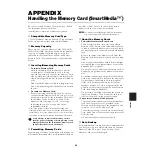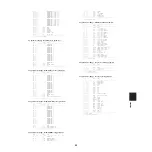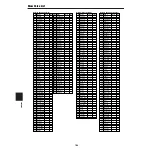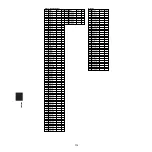
APPENDIX
97
3.2.2
bulk dump - drumkit data
$F0
...
$58
ID, ASCII char 'X'
$54
ID, ASCII char 'T'
$44
type, ASCII char 'D'
$4B
type, ASCII char 'K'
$49
type, ASCII char 'I'
$54
type, ASCII char 'T'
$00
fix
$00
fix
numM
drumkit number MS7bit
numL
drumkit number LS7bit
data
data
...
data
csum
check sum
$F7
Drumkit number is a user drumkit number counted from 0 (counted
from 1 in the panel display).
Drumkit number $7F $7F ($3FFF) specifies the edit buffer.
See Data Tables for details of data.
3.2.3
chain dump - chain data
$F0
...
$58
ID, ASCII char 'X'
$54
ID, ASCII char 'T'
$43
type, ASCII char 'C'
$48
type, ASCII char 'H'
$41
type, ASCII char 'A'
$49
type, ASCII char 'I'
$00
fix
$00
fix
numM
drumkit number MS7bit
numL
drumkit number LS7bit
data
data
...
data
csum
check sum
$F7
Chain number is a user chain number counted from 0 (counted from 1
in the panel display).
Chain number $7F $7F ($3FFF) specifies the edit buffer.
See Data Tables for details of data.
3.2.4
bulk dump - song data
$F0
...
$58
ID, ASCII char 'X'
$54
ID, ASCII char 'T'
$53
type, ASCII char 'S'
$4F
type, ASCII char 'O'
$4E
type, ASCII char 'N'
$47
type, ASCII char 'G'
indM
index number MS7bit
indL
index number LS7bit
numM
song number MS7bit
numL
song number LS7bit
data
data
...
data
csum
check sum
$F7
If data is large, it is divided into multiple messages.
Song number must be counted from 0 (counted from 1 in the panel
display).
Song number $7F $7F ($3FFF) specifies the one song (current song).
Each data byte is divided into 4-bit MSnible and LSnible, and then
transferred as successive 2 bytes.
See Data Tables for details of data.
3.2.5
bulk dump - stack data
$F0
...
$58
ID, ASCII char 'X'
$54
ID, ASCII char 'T'
$53
type, ASCII char 'S'
$54
type, ASCII char 'T'
$43
type, ASCII char 'C'
$4B
type, ASCII char 'K'
$00
fix
$00
fix
numM
stack number MS7bit
numL
stack number LS7bit
data
data
...
data
csum
check sum
$F7
Stack number is specified with numM and numL ($00 - $0F for each)
and determines the user stack 1 - 16.
Each data byte is divided into 4-bit MSnible and LSnible, and then
transferred as successive 2 bytes.
See Data Tables for details of data.
3.3 Dump Request
When the DTXTREME receives dump request (reception only), it transmits
requested bulk data.
$F0
$43
$7D
$2n
n: device number
$44
ID, ASCII char 'D'
$54
ID, ASCII char 'T'
$58
ID, ASCII char 'X'
$54
ID, ASCII char 'T'
type1
type, ASCII char
type2
type, ASCII char
type3
type, ASCII char
type4
type, ASCII char
numM object number MS7bit
numL
object number LS7bit
$F7
Type specifies the type of bulk data. See the bulk dump format for
available types.
Object number specifies a unique number from multiple similar kinds
of data (like drum kit number, song number or so on). If the target
data is single (like system common data, edit buffer data or so on),
this value must be $7F $7F ($3FFF).
If there is only one song data on the DTXTREME, this does not mean
that data is single.
4. System Common Messages
5.1 Song Select
$F3 $nn
nn is song number.
Reception only.
5. System Realtime Messages
Supports both transmission and reception.
5.1 Timing Clock
When the "MIDI sync mode" system parameter has a value of "ext" or "auto,"
the DTXTREME synchronizes to incoming timing clock.
5.2 Start, Continue, Stop
When the "MIDI control" system parameter is set to off, the DTXTREAME does
not receive start, continue and stop messages.
5.3 Active Sensing
Reception: If an active sensing message is received and there is no
subsequent MIDI data coming in for approximately 300 milliseconds, the
DTXTREAME will mute all current sounds playing.
Transmission: The DTXTREME transmits MIDI data including active sensing
message every (approximately) 300 milliseconds
Содержание DTXTREME
Страница 1: ......
Страница 136: ...String Guitar Percussion Division Yamaha Corporation 2000 Yamaha Corporation Printed in Taiwan ...









































